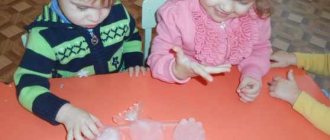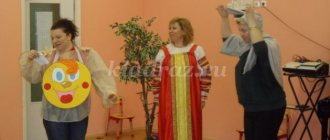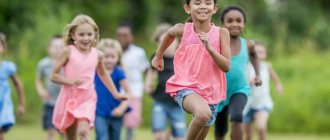Summary of a lesson on speech development for the second junior group “Reading the fairy tale “Kolobok”
Gavrichkova Ksenia
Summary of a lesson on speech development for the second junior group “Reading the fairy tale “Kolobok”
Goal: To introduce children to the Russian folk tale “ Kolobok ”
, introduction to oral folk art, continue to teach children to carefully examine illustrations in books.
-development of coherent speech and enrichment of children’s vocabulary;
-development of attention and memory of children;
-education for Russian folk tales ;
-development of the ability to describe what is seen.
3. Type of lesson : combined.
4. Form of lesson : reading-discussion .
5.Duration: 15 minutes.
6.Age of students: 3-4 years.
7.Equipment and materials: books with the fairy tale “ Kolobok ”
different artists, toy
bun .
-verbal: reading fairy tales , children's stories , conversation;
-visual: looking at illustrations.
9. Lesson .
1. Introductory part Checking the readiness of children for the lesson (appearance, concentration of attention)
1 minute
2. Main part Organizing children's attention (a surprise moment, reading a fairy tale and looking at illustrations in books. 10 minutes.
3. End of the lesson Summing up : description of the fairy tale by children using a mnemonic table and assessment of children’s participation. 4 minutes
10. Lesson progress
The chairs in the group are placed in a semicircle, the children sit on the chairs.
There is a knock on the door. The teacher opens and asks the children a riddle:
-It was baked from flour,
It was mixed with sour cream,
He was chilling at the window,
He rolled along the path.
He was cheerful, he was brave
And on the way he sang a song. Who is this?
-Right. This is a bun . (Teacher shows a toy kolobok )
.
-Who knows the fairy tale about our kolobok ?
-Let's read a fairy tale about our guest , I think he will be pleased with our interest.
The teacher reads a fairy tale , trying to convey emotions.
-Are you tired? Let's relax a little and play with our hands. Repeat after me .
-Knead the dough quickly (open and close your palms,
- Divided into pieces (simulate pinching off,
-Roll out all the pieces (three palms together)
-And we made little buns (we show 2 fists)
-Now let's go to the table. What lies on it? - Books.
-That's right, books about our hero. different artists depicted . (Children look at books with images of koloboks .)
-Which bun did you like best and why?
Children answer and describe.
3. End of class .
-We looked at the illustrations, told why we liked the koloboks , and now let’s repeat the fairy tale .
Next, the teacher gently evaluates each child’s participation.
Children tell a fairy tale .
Summary of a lesson on speech development in the senior group “Reading the fairy tale by D. Rodari “The Cunning Pinocchio” Summary of a lesson on speech development in the senior group on the topic: Reading the fairy tale by D. Rodari “The Cunning Pinocchio”. Implementation of program content.
Summary of educational activities for speech development in the second junior group “Reading poems by S. Ya. Marshak from the cycle “Children in Cages” Topic: “Reading poems by S. Ya. Marshak from the cycle “Children in Cages”. Objectives: Educational: to arouse children's interest in listening to poetry. Summary of an open lesson on speech development. Reading the fairy tale “The Great Cold” by S. Prokofieva. Summary of an open lesson on speech development. Reading the fairy tale by S. Prokofieva “The Great Cold” Purpose: To please children by reading a new fairy tale by S. Prokofieva.
Summary of an open lesson in the middle group on speech development “Reading the Russian folk tale “The Little Fox and the Gray Wolf” Purpose: To introduce children to the Russian folk tale “The Little Fox and the Gray Wolf”, to help evaluate the actions of the heroes. Preliminary work:.
Summary of a lesson on speech development in the second junior group “Reading the Russian folk tale “The Fox and the Hare”” Gorskaya Natalia Yuryevna Summary of speech development in the second junior group Reading the Russian folk tale “The Fox and the Hare” Objectives: To introduce.
Summary of a lesson on speech development. Telling the fairy tale “Kolobok” using the modeling method. Summary of a lesson on speech development in the second group of early age. Telling the fairy tale “Kolobok” (using the modeling method).
Source
Physical education in the junior group “Vesyoly Kolobok”
Goal : strengthening the physical and mental health of children through Russian folklore.
Tasks.
1. Induce a positive, emotional attitude in children;
2. Improve motor skills;
3. Develop balance and coordination of movements;
4. Create a desire to engage in physical education.
Preliminary work : teaching children basic types of movement; learning outdoor games; reading to children n. With. "Kolobok"; theatrical performance of a fairy tale.
Leisure time is spent in the gym.
Move
Children enter the hall to the music - formation.
They do physical exercises with their grandmother.
Physical school
The grandmother kneaded neither a bun nor a pancake (hands clasped, circular movements left and right)
Took it out of the oven (arms up, to the sides, down)
No pie, no rolls (torso turns left - right, arms to the sides)
How I put it on the table (squats)
He left his grandparents (jumping)
Who runs without legs? (claps hands)
This is a yellow BALL! (together)
(The grandmother bakes a Kolobok, and at the end she puts a Kolobok mask on the child.)
Host: - Guys, remember the fairy tale about Kolobok?
Children: - Yes.
Host: Where did he run away to?
Children: - Into the forest!
Host: Who did he meet?
Children: - A hare, a wolf, a bear and a fox!
Presenter: - Yes, guys, I'm in trouble! Let's save Kolobok from trouble today - shall we go for a walk with him?
Together with the children, they go for a walk through the forest while listening to music.
They meet a hare.
Hare: - Kolobok, Kolobok, I will eat you!
Kolobok: - Don't eat me!!!
Presenter: - Guys, we need to save Kolobok! If you, Bunny, are hungry, would you like us to feed you? Let's harvest for you!?
Hare: - I want it, I really want it!
Game “Harvest” (two baskets: children collect carrots in one, cabbage in the other).
Children treat the bunny with collected vegetables.
Hare: -Thank you, guys, for the delicious and healthy vegetables! I won't eat your Kolobok! Have a nice trip!
The presenter and the children continue to walk through the forest to the music.
They meet a wolf.
Wolf: - Kolobok, Kolobok, I will eat you!
Kolobok: - Don't eat me!!!
Host: - Why, Wolf, do you look bad?! Do you do exercises in the morning?
Wolf: - What is charging???
Presenter: - And we’ll show you now!
Children do musical exercises “Exercising the Animals” together with the wolf.
Wolf: - This is a good thing - CHARGING! I will do this every morning! I won’t eat your Kolobok! Bon Voyage!
The presenter and the children continue to walk through the forest to the music.
They meet a bear.
Bear: - Who are you?
Kolobok: - Kolobok is a ruddy side!
Bear: - I slept for so long that my sides were still lying down! After hibernation I'm hungry! So I'll eat you!
Host: - No, Mishka, don’t eat our Kolobok! Do you want us to play with you and help you stretch your bones?
The outdoor game “Game with Teddy Bear” is carried out.
Bear: - Thank you, guys! Now I feel good, I won’t eat your kolobok! Bon Voyage!
The presenter and the children continue to walk through the forest to the music.
They meet a fox.
The fox walks alone in the forest.
Fox: - Oh, how boring it became in the forest! No music, no songs, no dances have been heard for a long time!
Sees children with Kolobok:
Fox: - Oh!!! Kolobok, I will eat you!
Kolobok: - Don't eat me!!!
Host: “Come on, Foxy, we’ll dance and make you laugh.”
Everyone dances the “Kolobok” dance together.
Lisa: - Thank you, children! You made me laugh. I won't eat your Kolobok! Bon Voyage!
The presenter and the children walk to the grandmother's hut to the music.
Grandma sees them and is happy.
Grandmother: - Thank you, guys, for not letting my Little Kolobochka go to waste! I won’t let you go just like that - accept my gifts!
Grandmother treats the children.
The children snake their way out of the hall to the music.
Notes for the 2nd junior group of kindergarten Topic: “Looking for a bun. »
Notes in the 2nd junior group of kindergarten
Topic: “Looking for a kolobok.” »
Educator: Kotvitskaya Nadezhda Ivanovna
GKKP "Nursery-garden No. 54 of the akimat of Kostnaya
Department of Education of Kostanay
Target:
To promote the development of interests, curiosity, and cognitive motivation of children through the fairy tale “Kolobok.”
Tasks
: Consolidate with children knowledge about r.n. fairy tale "Kolobok"
Develop children's speech, achieve clear pronunciation of words.
Develop social and emotional intelligence, emotional responsiveness, empathy.
To instill in children responsiveness and a desire to help each other.
Equipment and materials
: Animal toys, exercise mat, hemp.
Preliminary work:
Reading a Russian folk tale: “Kolobok,” asking riddles, looking at illustrations
Move
Educator:
Today I invite you to visit the kolobok.
1-2-3 turn around and find yourself visiting the kolobok. Look, the bun is not visible, only the grandmother is sitting and crying. Let's ask what happened and where the bun is.
Children:
Hello grandma, why are you crying?
Grandmother:
I scraped the bottom of the tree, I swept the barn, I kneaded the dough, I baked a bun. And he rolled disobediently into the forest and probably got lost. Help the children get him back.
Educator
: It’s a pity for grandma and the bun.
Children:
Let's find the bun and return it to grandma.
Dynamic pause “Along the forest path”
(Children walk one after another along the correction mat, step over stumps, jump over bumps to the music.)
Educator:
There is a forest and a path in front of us.
Look, who is that hiding from us in the bushes, only his ears are trembling?
Children:
Yes, this is a cowardly bunny.
Educator:
Come out, don't be afraid.
Children:
Hare, have you seen the bun?
Hare:
I saw it, but first help me collect vegetables and fruits for my bunnies in baskets.
Didactic game: “Fill the basket.”
Hare:
Thank you, here is a carrot and the bun rolls further along this path.
Children
: Thank you too, bunny.
Educator
: Look, a wolf is sitting on a stump. Let’s ask him if he has seen the bun.
Children:
You're a top, a gray barrel, haven't you seen a bun? His grandmother baked it, put it on the window, and he rolled off into the forest.
Wolf
: I'm bored in the forest, play with me.
Educator:
The wolf loves to play ball. Let's play with him.
"Outdoor game "Roll the ball into the goal"
Wolf:
Thanks for playing with me. Here's a ball for you, follow it wherever it rolls.
Children:
Thank you, goodbye top.
Educator
: Oh, who is that stomping loudly throughout the forest? Yes, it's a bear.
Children:
Hello, little bear. Have you seen the bun?
Bear:
I saw, I saw a kolobok, he was singing songs here. But you guess my riddle, then I’ll show you where he went.
1 Who threw a pine cone at the kids from the tall dark pines? And flashed through the bushes through a stump like a light?
squirrel
| 2He looks like a shepherd, Every tooth is a sharp knife! He runs, baring his mouth, ready to attack the sheep. |
| wolf |
3Kolobok made from needles. Who's curled up in a ball here? You won’t understand where the tail is, where the nose is, He carries food on his back. In general, you won’t understand right away. Who is this anyway?
hedgehog
| 4Which animal has the fluffiest and longest tail? |
| fox |
Bear:
How smart you are, here's a barrel of honey for you. Follow this path, there is a fox living further, ask her.
Educator:
Oh guys, we need to hurry. The fox is cunning, she will eat the bun.
Fox:
Kolobok, sit on my sock and sing your song.
Educator:
Look, the bun is sitting on the fox’s nose.
Children:
Kolobok. Kolobok, don’t sit on the fox’s toe, she will eat you. Go back to grandma.
Kolobok
: Thank you guys for saving me from the fox. I was rolling along the path and got lost in the forest. I myself want to return to my grandmother. (The children take the bun and take it to their grandmother.)
Grandmother:
Thank you for helping me return the bun. Here's a basket of pies for you on the way.
Educator:
Now it’s time, kids, to say goodbye to the fairy tale and return home.
Used Books:
A collection of riddles. Comp. M.T. Karpenko. – M. Education, 1988
Russian folk tale "Kolobok".
Notes on speech development in the second junior group “Reading the fairy tale “Kolobok”
Tatiana Chertygasheva
Notes on speech development in the second junior group “Reading the fairy tale “Kolobok”
Goal: to introduce children to the Russian folk tale “ Kolobok ”
, introduction to oral folk art, continue to teach children to carefully examine illustrations in books.
-development of coherent speech and enrichment of children’s vocabulary;
-development of attention and memory of children;
-education for Russian folk tales ;
-development of the ability to describe what is seen.
Equipment and materials: books with the fairy tale “ Kolobok ”
different artists, toy
bun .
-verbal: reading fairy tales , children's stories , conversation;
-visual: looking at illustrations.


